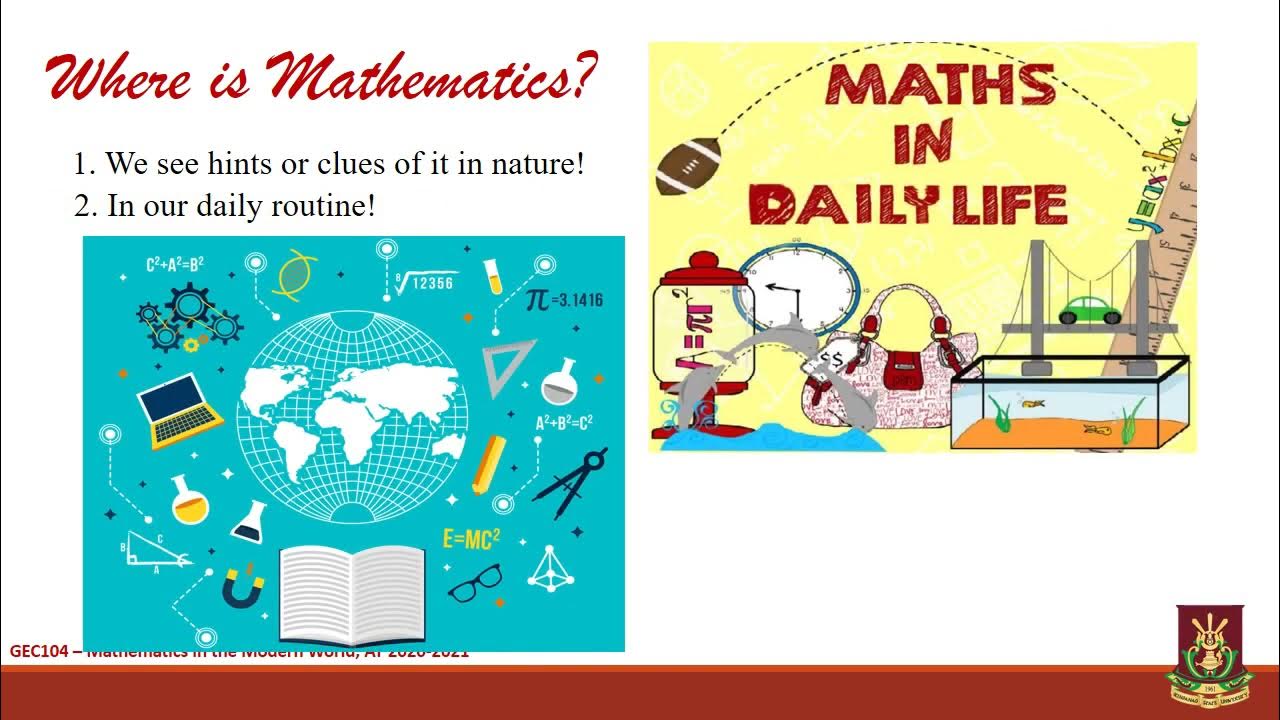NATURE OF MATHEMATICS (Mathematics in the Modern World)
Summary
TLDRThis tutorial explores the nature of mathematics, focusing on its patterns in nature and its fundamental role in our world. It explains how mathematics is used in everyday life, from predicting weather patterns to counting populations. The video introduces key mathematical concepts such as natural numbers, integers, rational and irrational numbers, and operations. Additionally, it highlights the importance of mathematical proofs, functions, and the process of signification. The tutorial emphasizes that mathematics is everywhere, engaging curiosity, and is essential for problem-solving and reasoning.
Takeaways
- 📚 Mathematics is deeply connected to the patterns in nature and the world around us.
- 🔢 Mathematics is all about numbers, starting from natural numbers, integers, rational numbers, real numbers, and complex numbers.
- 🐇 The Fibonacci sequence is explained through the example of rabbit reproduction patterns.
- 📊 Mathematics helps organize patterns, regularities, and irregularities in the world to predict and control events like epidemics or weather.
- 🌿 Natural patterns, such as the number of petals in flowers, often follow mathematical rules.
- 📐 Mathematics is not only about numbers but also about operations such as addition, subtraction, multiplication, and division.
- 📈 Functions are an essential part of mathematics, often represented through algebraic formulas like 2x = y.
- 💭 Mathematics involves abstraction and turning abstract concepts like numbers into tangible things (e.g., 5 cars, 4 children).
- 🔍 Proofs are fundamental to mathematics, providing reasoning and justification for why certain mathematical principles hold true.
- 👨🎨 Doing mathematics can be similar to creating art, driven by curiosity and creativity.
Q & A
What are the main learning outcomes of the video?
-The main learning outcomes are to identify patterns in nature, articulate the importance of mathematics in life, argue about the nature of mathematics, and express appreciation for mathematics as a human endeavor.
How does the video explain the relationship between mathematics and patterns in nature?
-The video explains that the simplest mathematical objects are numbers, and the simplest patterns in nature are numerical, such as the number of petals in flowers and the spiral patterns found in nature.
What is the Fibonacci sequence and how is it demonstrated in the video?
-The Fibonacci sequence is a series of numbers where each number is the sum of the two preceding ones. In the video, it's demonstrated through an example of rabbit reproduction, showing how pairs of rabbits grow in numbers over time.
How is mathematics used to predict or control natural phenomena according to the video?
-Mathematics is used to organize patterns and regularities, predict or control events like weather and epidemics, and provide tools for calculations.
What is the significance of zero in the history of mathematics?
-Zero represents 'nothing' and was a key invention that expanded the number system. It allowed for the development of more complex mathematical concepts such as negative numbers.
How are numbers categorized in the video?
-Numbers are categorized into natural numbers, integers, rational numbers, real numbers, and complex numbers. These represent different types of numbers used in various mathematical contexts.
What are the four fundamental operations of mathematics mentioned in the video?
-The four fundamental operations mentioned are addition, subtraction, multiplication, and division.
What role do functions play in mathematics according to the video?
-Functions are explained as relationships between inputs and outputs, often defined using algebraic formulas. For example, multiplying a number by two is a simple function.
What is meant by 'signification' in mathematics?
-Signification refers to the process of turning an abstract concept, like a number, into something concrete, such as associating the number 'four' with four children or five with five cars.
What is a mathematical proof, and why is it important?
-A mathematical proof is an argument or justification that demonstrates why something is true. It answers questions like why '2 + 2' equals '2 times 2' through logical reasoning, making proofs essential for validating mathematical statements.
Outlines

هذا القسم متوفر فقط للمشتركين. يرجى الترقية للوصول إلى هذه الميزة.
قم بالترقية الآنMindmap

هذا القسم متوفر فقط للمشتركين. يرجى الترقية للوصول إلى هذه الميزة.
قم بالترقية الآنKeywords

هذا القسم متوفر فقط للمشتركين. يرجى الترقية للوصول إلى هذه الميزة.
قم بالترقية الآنHighlights

هذا القسم متوفر فقط للمشتركين. يرجى الترقية للوصول إلى هذه الميزة.
قم بالترقية الآنTranscripts

هذا القسم متوفر فقط للمشتركين. يرجى الترقية للوصول إلى هذه الميزة.
قم بالترقية الآنتصفح المزيد من مقاطع الفيديو ذات الصلة

Mathematics in the Modern World Lesson 1 (Math 101)

MMW Lesson 1.4 Mathematics for Our World

Nature's Numbers By: Ian Stewart (Chapter 2: WHAT MATHEMATICS IS FOR?)

Painted with numbers: mathematical patterns in nature

GEC104 Video Lecture 1 - Mathematics in our World (Part 1)

GEC104 Video Lecture 1 Mathematics in our World Part 1
5.0 / 5 (0 votes)
